This series, later given the tag line 'Adventures in History', first appeared in 1984, a couple of years after Esci first started making soft plastic figure sets. The first two Historic Battle sets were Zulu War and Napoleonic, which appeared at the same time as their first non-WWII figures, so right from the start Esci made the most of their Historics figure range. Unfortunately all these disappeared in the early 1990s, and have not been seen since, although AMT did produce a few new ones later.
Below is a list of all the products produced in this range, with an indication of the figures and other elements to be found in each. Click on any thumbnail to see a bigger copy of that image, or on the name of the figure set to see more details and our review of that product. Note however that it is possible that different bases were sometimes included in the same set at different times, so the one associated here is only the first used.
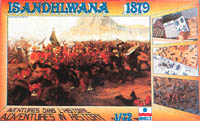
This contains two full sets of British Infantry Soldiers and two full sets of Zulu Warriors. It also contains a vacu-formed base and a leaflet with a brief history of the battle and painting instructions.
Released in 1984, this was the first of the Historic Battle series, and it used the first non-World War II figures Esci made. It is an interesting choice when so many manufacturers would have gone for Napoleonics or Romans first. The base has clearly been carefully thought out as it is meant to resemble the famous battlefield, with a miniature representation of the famous mountain (which has a separate 'top' to add more height). The format for the series was largely set right from the start with this set, although future sets would also include a set of accessories, and the box design would change in the following year.
Our box artwork above shows the second type design, which will be more familiar to most; the first type box is shown below, along with the base provided for this set.
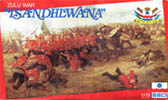
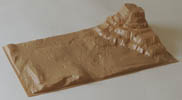
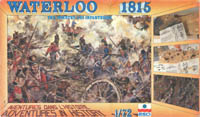
This contains two full sets of
British Infantry, two full sets of
French Imperial Guard and a set of
Battlefield Accessories. In addition there is a vacu-formed base and a leaflet with a brief history of the battle, assembly instructions for the accessories and painting instructions.
Also made in 1984, the set appeared the same year as the individual figure sets. The accessories are not particularly appropriate here as they mostly offer the ability to create wooden barriers, chevaux-de-frise and sandbag emplacements, none of which would have been seen on the field of Waterloo. Also the title changed slightly over the course of time. Originally the title was simply 'Waterloo 1815', but it became necessary to add the 'Infantry' word when they wanted to produce other Waterloo sets later on. Of course at no point at Waterloo did Highlanders defend themselves against the Old Guard from behind sandbags, but it still looked good to many a small boy! The base for this one would in time be used for many in the series as it is fairly generic, with a road curved across one corner and a remarkably high number of dismounted cannon barrels on the ground!
The major artwork on the box is clearly done by a different hand to the rest of the range, but like all the second-type boxes this one includes some tantalising glimpses of the set in a series of photos on the right-hand side of the box front, for which see below. Also below is the first-type box, and an illustration of the finished model which appeared in the 1986 catalogue. The painter has made a nice job of the figures and the base, but seems to have lost interest part-way through the accessories, some of which are not fully painted. Also below is a clear image of the base.
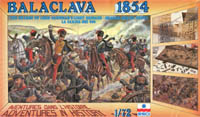
This contains two full sets of
Lord Cardigan's 11th Hussars, two full sets of
Russian Infantry and Artillery and a set of
Battlefield Accessories. In addition there is a vacu-formed base and a leaflet with a brief history of the Charge of the Light Brigade at Balaclava, assembly instructions for the accessories and painting instructions.
Released in 1985, this too is a set where the accessories are not suitable for Balaclava as the Russians had not been able to construct any sort of fortifications at the position of their artillery. The base sort of suggests a valley in as much as it has higher ground on either side, but of course the main problem with this is that it ignores all but one of the regiments who made up the Light Brigade.
The box was of the second, more familiar type right from the start, so includes some tantalising glimpses of the set being prepared and then painted, for which see below. Also below you can see the base used for this Crimean War set.

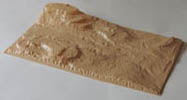
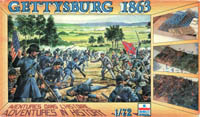
This contains two full sets of the new
Union Infantry, two full sets of the equally new
Confederate Infantry and a set of
Battlefield Accessories. In addition there is a vacu-formed base and the usual leaflet with a brief history of the battle, assembly instructions for the accessories and painting instructions.
1985. The base for this set has some fairly sophisticated entrenchments which look more appropriate to World War I than Gettysburg, and of course while the ground is convincingly uneven, it did make it harder to get the figures to stand.
As usual the box showed an exciting artwork which told you little about exactly what was inside, but it also had the three panels on the right with photos of the set being prepared and painted, for which see below. Also below is the base included in the set.

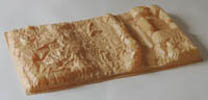
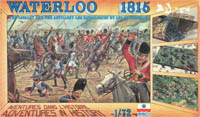
This contains two full sets of
'Polish Lancers', two full sets of
'Scots Greys', one full set of
British and French Artillery and a set of
Battlefield Accessories. In addition there is a vacu-formed base and leaflet with a brief history of the charge of the Union Brigade at Waterloo, assembly instructions for the accessories and painting instructions.
This was the second set for 'Waterloo', utilising the new cavalry and artillery sets that were also released in 1985. Esci included two of each cavalry set, plus a single copy of the artillery set, which meant you got more than the normal number of sprues in a box, but only two guns and crews per belligerent, since this battleset predates the later Esci splitting of this artillery set into two. The vacu-formed base has no particular features, but is reasonable enough, so with the extra artillery sprue this is the best filled box in the series. The leaflet is particularly hilarious, however. Not only does it somewhat mangle the English language, as they all do, but the author repeatedly fails to understand the difference between English and British. At one stage he even states the Scots Greys were part of the English cavalry, an ignorance likely to infuriate any Scotsman of the time or since!
The box artwork could not resist showing some infantry, in fact French Imperial Guard, so at the same time it was both being very careless with the actual historical event and also free in what the box contains, since there are no infantry to be found. However the usual three-panel arrangement on the right side helps to give a better picture of the actual contents, which can be seen below. Strangely, however, two of the photos are reversed, so all the lancers hold their lances in the left hand, all the Scots Greys hold their sabres in the left, and all the artillery are also sinister!


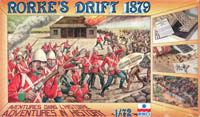
This contains two full sets of
British Infantry Soldiers, two full sets of
Zulu Warriors and a set of
Battlefield Accessories. In addition there is a vacu-formed base and a leaflet with a very inaccurate history of the action, accessories assembly and painting guide.
Another of the quartet of releases in 1985, this set was pretty much the same as the preceding Isandhlwana set in that it had exactly the same figures, but with the addition of the sprue of
Battlefield Accessories. In this case the accessories are really important, since you could attempt to make some sort of barrier such as were fabricated at the real Rorke's Drift, and the base in this set has a number of low walls which the child could use as a foundation (pun intended) for the walls of the farmhouse etc. Needless to say this is nothing like the real Rorke's Drift farm, but as a playset it works well enough. The leaflet is another piece of poor research, since it refers to the 24th Regiment as 'English' when in fact the regiment was based in Wales and had a high proportion of Welshmen in the ranks (as well as English, Scots and Irish as usual). Essentially however this is another attempt to make the two Zulu War figure sets go even further as it offers nothing much that was new.
The inaccuracies of the box artwork speak for themselves, but again you also got the three photos of the actual set, which can be seen below along with the base.

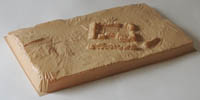
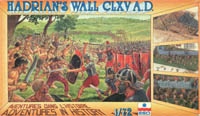
Nor surprisingly, this contains two full sets of
Roman Legion, two full sets of
Barbarian Warriors and a set of
Battlefield Accessories. Also there is a vacu-formed base and a leaflet with a brief commentary on the wall, a guide to the assembly of the accessories and notes on painting.
This was the first of the 1986 crop of new releases, and delved far further into ancient history than Esci had ever done before, or would ever again. The base in this set makes a surprisingly good job of delivering a section of wall, although this was far shorter and less impressive than the real Roman fortification. Also there were a number of gaps in this wall, which helps allow the figures to get to grips with one another, but is hardly a feature of the real thing! The date of this encounter, CLXV (or 165 CE to the modern reader), seems like a random choice, probably because it looked quite good when written out. Strangely the box artwork shows no masonry whatsoever, so perhaps the idea to call it Hadrian's Wall was a late decision. Certainly some of the 'Barbarians' work less well as inhabitants of northern Britain.
The usual three photos of the model give a better idea of what can be achieved with the components on offer, as does the photo of the base, which is about the nicest element of this particular battleset in our view.

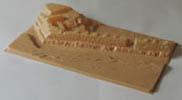
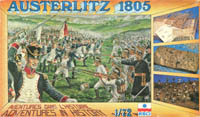
This contains two full sets of
French Line Infantry, two full sets of
Prussian and Austrian Infantry and a set of
Battlefield Accessories. Also in the box is a vacu-form base and a leaflet with painting and assembly instructions plus a brief history of the battle.
Now everyone knows that the Prussians were not at Austerlitz - indeed they were not even at war with France at the time, so fully a quarter of the figures provided in this set are useless for Austerlitz. The artist seems to be well aware of this nonsense, and so in the main picture the Prussian figures are present but as far in the background as possible. In the side panels all the figures have been used, so we do see the Prussians as much as the Austrians, which is just silly but all thanks to Esci thinking they could get away with making one set of figures to cover two completely different battles (see 'Jena' below). This set came out in 1986, before Esci made their set of Russian infantry, so a massive element of the battle has no representation whatsoever. Thanks to the choice of figures then, this is a strange and very unsatisfactory product.
The usual photos of the finished product on the box have been added below for closer inspection. However a very curious aspect of these photos is that they are all reversed, so every man is left-handed! This is not the first time this was done, and there seems no obvious reason why it would be deliberate (sometimes aesthetic considerations cause reversing to be selected), so we must assume this is sloppy work on the part of the art department. However the strangest thing about these is that whoever put them together has used both French Line Infantry and French Imperial Guard. Perhaps the original intention had been to include one sprue of each, but as far as we can tell this never actually happened.

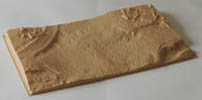
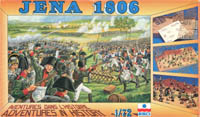
This contains two full sets of
Prussian and Austrian Infantry, one full set of
French Line Infantry, one full set of
French Imperial Guard and a set of
Battlefield Accessories. A surprising vacu-formed base joins the figures in the box, as does the obligatory leaflet containing a potted history of the battle, instructions for the assembly of the accessories, and a painting guide for the French, Prussian and (amusingly) Austrian soldiers.
This was another set produced in the same year as the Austrian/Prussian figure set - 1986 - so clearly the figure set was made to provide for both these battlesets, which could reasonably be described as sisters since they are almost identical in content! This ridiculous arrangement means we have 50 Austrian troops in this set with no connection at all to the battle of Jena, and as with the Austerlitz set the artist has made the Austrians as inconspicuous as possible on the main artwork. Perhaps in an attempt to make this set look different to the Austerlitz set, Esci included both line and guard infantry on the French side. The chosen base is odd in that it has a section of wall in one corner, for reasons we cannot guess.
Below is the close-up of the photos on the box, which may show the Austrians in some numbers but are at least the correct way round this time. Also shown is the odd choice of base design for this set.

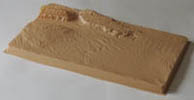
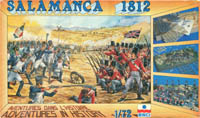
This contains two full sets of
British Infantry, two full sets of
French Line Infantry and a set of
Battlefield Accessories. In addition there is a vacu-formed base and a leaflet with a brief history of the battle, assembly instructions for the accessories and painting instructions.
This uses the same base as Rorke's Drift, with the footings of a building as the only feature - an odd choice for this battle, where buildings played no part. The various weaknesses of the sets are discussed in the reviews, but of particular note is that the British infantry would have worn the stovepipe shako, not the 'Belgic' shako these British figures wear. In this regard at least the artist of the box got it right (although he has chosen light infantry anyway).
Below are the expanded view of the box photographs, and the surprising base piece.


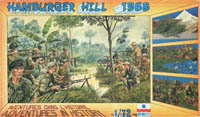
This contains two full sets of
US Elite Forces and two full sets of
North Vietnamese Soldiers and Vietcong, plus the sprue of
Battlefield Accessories, and the base and leaflet with a brief discussion of the nature of warfare in Vietnam, assembly and painting guide.
In many ways this is the most absurd of the whole range of battlesets Esci produced, although how many children cared about that we will never know. The idea that quantities of US troops stood and blazed away at similar numbers of North Vietnamese and Viet Minh fighters across a narrow river is the purest nonsense, and it makes for both a bizarre drawing on the box and a tricky thing to try and model inside. While the figures themselves are pretty good, you simply cannot recreate the terrain and vegetation of Vietnam on a vacu-formed base, so instead the makers went for an entrenchment-style, which is probably as good as they could have got under the circumstances. Nevertheless this is the strangest of the 1986 releases, and particularly interesting since they also produced the Saigon - Tet Offensive set in their Diorama series, which has similar issues.
The three photos of the actual set, as shown on the front of the box, are reproduced below, along with the base which had to pretend to be Vietnamese jungle.


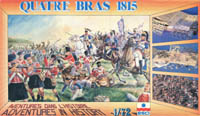
This contains two full sets of
British Infantry, two full sets of
French Cuirassiers and a set of
Battlefield Accessories. In addition there is a vacu-formed base and a leaflet with a brief history of the battle, assembly instructions for the accessories and painting instructions.
1987 saw the release of Esci's French Cuirassiers set, and with it the opportunity to use them to create more Napoleonic battlesets. To be honest, creating a set for Quatre Bras does smack of grasping at straws rather since, while a vital battle in the run-up to Waterloo, it is always overshadowed by the later decisive battle. In any event Quatre Bras was a battle with considerable Dutch, Belgian and German involvement, which is at least acknowledged in the leaflet text if not in the figures. Although always somewhat fanciful, the box artwork for this set shows cuirassiers in amongst a disordered and open group of infantry, so you wouldn't bet on the British troops in that situation.
Below we show the photos of the model on the box, which seems to show a fairly disorganised frontal attack by the cavalry on a body of infantry. However the 1987 catalogue also had a wider photo of the same made-up model, which is also below. Here we can see the nicely painted figures, but the arrangement is very peculiar. The cuirassiers seem to be trapped between two groups of British infantry out of formation, and with a clutter of accessories impeding their horses! The base used in this set was the generic one seen in several previous sets, which would now be used in all the remaining titles in the series.
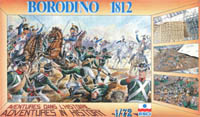
This contains two full sets of
Russian Grenadiers, two full sets of
French Cuirassiers and a set of
Battlefield Accessories. In addition there is a vacu-formed base and a leaflet with a description of the battle, assembly instructions for the accessories and painting instructions.
With the new cuirassiers and Russian Grenadiers, Esci had the necessary key elements for a Borodino set, so here it is. No mixing of nationalities this time, so every figure is useful and relevant. A simple enough set but very nice to see figures for Russian troops at a time when no one else had made any. Esci could have made more of an effort with the base here, designing a new one with some representation of the Great Redoubt, but as it was we got a generic battle scene.
Below can be seen the photos of the model, and the chosen base.


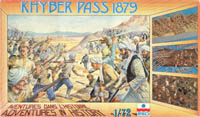
Contains two full sets of
British Infantry, two full sets of
Muslim Warriors and a set of
Battlefield Accessories. In addition there is a vacu-formed base and there was also a leaflet with a brief history of the Khyber Pass, assembly instructions for the accessories and painting instructions.
Another of the four new battlesets in 1987, this one returned to the theme of the very first one - colonial wars. Now that they had made their very mixed set of 'Muslim Warriors', and tweaked their set of Zulu War British to make an Indian Army version, this set became possible. The base they supplied was the usual fairly featureless one, but we think they could have used the slightly 'valley' one seen in the Balaclava set, since if nothing else the Khyber Pass was very much a valley! Indeed we understand that this base was indeed found in some copies of this set, so perhaps Esci saw the same logic as us. Naturally the box artwork and the photos concentrate on the 'Afghan' parts of the Muslim set.
Below you can see the photo panel and the base. Can you spot the cheat in the photo of the finished model? At centre stage is an officer with a revolver, yet this figure comes from the French Foreign Legion set and so is not in this box, which is a bit sneaky!


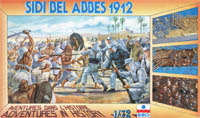
This contains two full sets of French Foreign Legion, two full sets of Muslim Warriors and a set of Battlefield Accessories. In addition there is a vacu-formed base and a leaflet with a brief history of the Legion, assembly instructions for the accessories and painting instructions for both legionnaire and native.
The last of the 1987 offerings, and as it turned out the last one ever made. There never was a Battle of Sidi Bel Abbes, in 1912 or any other year, and the Legion were not involved in any particularly significant battle in 1912. Sidi Bel Abbes was closely associated with the Legion because a training camp and the headquarters of the First Foreign Regiment were located there. Esci invented this 'battle' to provide a reason for making a battleset based on their new French Foreign Legion and Muslim figures. Perhaps it might have been better to choose a name like 'Fort Zinderneuf', even though that is fictional. Anyway, as discussed in the review of the Muslim Warriors, some of the figures look much more Afghan or Sudanese than Algerian Arabs, so not every figure in this box is really suitable. The base shown on the box artwork is the one with the large number of abandoned and dismounted cannon barrels, as shown below, which is hardly the sort of thing you might expect in this kind of a battle. However some extant copies of this set suggest that some at least were packed with the same base as that for the Jena set, with a random bit of wall, which is at least marginally more appropriate.
For the last time, we reproduce the box photos below along with the advertised (but not necessarily included) base.


All the sets remained in the catalogue for several more years, but no new ones were ever put together. The late eighties saw new sets of 'modern' (NATO/Warsaw Pact) figures, which hardly lend themselves to this sort of playset, and in the event such troops never traded fire on any battlefield. Although new figure sets of ancient (Punic Wars), medieval (Hundred Years War) and American Civil War were planned Esci never released them, so perhaps there would have been more battlesets based around those. We shall never know, but for many the sight of those large red boxes stuffed with figures made any trip to the model shop a magical one in the later 1980s, even if they couldn't buy them, so while they still appear on ebay from time to time they are fairly rare these days, but will always have a place in this small boy's heart.